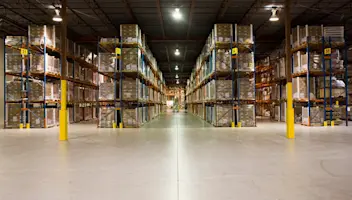Future-Proofing Your Consumer Goods Business With the Right Distribution ERP Software
Future-Proofing Your Consumer Goods Business With the Right Distribution ERP Software
Future-Proofing Your Consumer Goods Business With the Right Distribution ERP Software
15 Sep 2023
Aptean Staff Writer
To remain competitive and relevant in the market, consumer goods importers and distributors have learned to leverage technology in their operations and have accepted the fact that technology evolves fast—in fact, today’s advancement could be tomorrow’s legacy. In this line of business, you need to remain agile and pivot quickly whenever there’s a new trend, to help maintain customer satisfaction and your edge in the market.
The consumer goods industry only grows more competitive with the continued dominance of eCommerce, with more companies trying to gain the attention of your loyal customers. For example, it was recently announced that TikTok is launching an eCommerce platform to help Chinese merchants sell products in the U.S. with plans to open additional markets over time. This ease of merchants selling globally continues to drive up competition in the consumer goods industry.
Now’s the time to be proactive and evaluate your current tech stack to further boost productivity and reduce costs. Implementing an industry-specific distribution enterprise resource planning (ERP) solution can help future-proof your business and gain a competitive advantage in the global arena.
If your business is currently using disparate systems, cumbersome paper-based documents or your legacy system doesn’t have all the functionalities of a robust ERP, it’s time for an upgrade—a purpose-built ERP system for the consumer goods industry that can help increase operational efficiency and optimize your entire supply chain.
In this blog, we’ll give you the information you need to build a strong business case—from the indicators that it’s time to implement a consumer goods ERP to the must-have features you need to consider to help maximize day-to-day operations.
Telltale Signs Your Current Tech Stack Is Costing Your Business
You may not immediately realize that your current tech stack is costing your consumer goods importer or distributor business, but if your software is out of date or doesn’t have the specialized functionality to help you respond to current industry challenges, you’re already behind the competition.
And that’s not considering the repercussions it has on your bottom line by limiting visibility, efficiency, productivity and company growth. Here are just a few examples:
You’re straining your workforce day-to-day just to meet increasing customer demands.
You lack real-time visibility of your in-transit and on-hand inventory.
Your processes require cumbersome workarounds, which include manual data entry.
You’re still using disparate systems in different departments resulting in scattered data.
You find it very hard to scale your operations and grow your business.
Your customers now prefer competitors with drop shipping options.
Experiencing some or all of these challenges? It’s likely because your current software doesn’t provide you with the specific functionality your business needs to streamline processes. This means the pain point signs are there and now is the time to re-assess your current solution and consider implementing a consumer goods ERP.
Ideally, your first step would be determining how much lost opportunity your current technology is costing you, which should include an analysis of your system’s limitations, documenting operational issues and how your organization could gain efficiencies from implementing a new system.
A Powerful Industry-Specific ERP Can Help Drive Success
Now that you’ve assessed where your operation can benefit from new or upgraded software, it’s time to compare the software options and providers and make your case for a specific solution. To do that, you’ll need to understand what systems and functionalities are available and how they can drive additional growth and future-proof your business.
Not all ERPs are the same. Many successful importers and distributors have found success with selecting an industry-specific ERP solution that can help with the unique business challenges you face—and partnering with a software vendor that speaks your language and understands your needs.
Aptean Distribution ERP is an all-in-one solution specifically designed for importers and distributors of consumer goods to help you manage operational processes with a single source of truth—including purchasing, importing, inventory, accounting, warehouse management and customer service.
Because trends like eCommerce and drop shipping are here to stay, you need a comprehensive ERP that offers purpose-built functionalities to give you an edge in the consumer goods industry.
Let’s now review the "must-haves" you should be looking for in an industry-specific distribution ERP to streamline your consumer goods business, then we’ll further discuss additional features that a robust system offers that will help you unlock additional profitability.
The Must-Have Functionalities of an Industry-Specific Distribution ERP
Forecast demand planning – enables you to leverage historical sales data and forecasts to help you improve purchase decisions.
Import and logistics management – gives you complete visibility of “true landed cost” and helps you manage inbound goods, including shipments direct to your customer from overseas.
Built-in warehouse management system (WMS) – supports multiple pick/pack/ship strategies for streamlined order processing.
Financials and accounting – provides financial ledger and accounting tools to help you optimize account payables and receivables.
Analytics and reporting – leverages accurate data to proactively adjust business plans based on market shifts, trends and patterns.
Fully integrated electronic data interchange (EDI) – enables your communication with eCommerce retailers and helps to ensure that your business is compliant with retailer requirements.
Built-In, Managed EDI Can Help Increase Data Accuracy
You’re likely very familiar with the aforementioned EDI because that’s how eCommerce retailers communicate with you when making transactions. Through EDI you receive purchase orders via EDI 850 documents which you then respond with order confirmations via EDI 855—and so on.
Compliance documents, shipping invoices, manifests and customs documents paperwork are some of the important electronic paperwork that goes back and forth through EDI; replacing all traditional paper-based exchanges of business documents with a digital format and eliminating human intervention.
If you’re sourcing your EDI from siloed third-party vendors, you’re at risk of having compliance errors which can result in significant profit loss if a retailer penalizes you with chargebacks. Third-party EDI vendors don’t primarily focus on retailer compliance which can be problematic for both the consumer goods distributor and retail customers. That’s just one reason it’s important to look for a consumer goods ERP with fully-integrated EDI functionality when you’re evaluating systems.
Moreover, having an integrated EDI eliminates time-consuming, error-prone and labor-intensive methods of creating orders for businesses geared towards direct-to-consumer (DTC) and those receiving high volumes of orders.
Enabling you to monitor and manage inventory in real-time, an integrated EDI and ERP system helps increase your efficiency, prevent costly chargebacks and ensure compliance because it allows you to:
Reduce labor costs
Improve data accuracy
Enhance supply chain visibility
For more on this topic, read our blog titled Top 5 Reasons You Need Managed EDI for complete details.
Additional Features Needed To Help Achieve Lasting Success
Now that you have a good understanding of the must-have functionalities of a tailored distribution ERP and the importance of having an integrated EDI, we’ll discuss the additional functionality that could help level up your business further.
Features of an ERP That Can Help Increase Efficiency for Importers and Distributors
Direct-to-consumer shipping – automates the process of high volumes of shipments to help you streamline operations.
Chargeback management – helps you reduce the number of the aforementioned chargebacks and recover charges through robust tracking and records maintenance.
Production lifecycle management (PLM) – offers you full visibility of a product’s entire lifecycle—from development, production, sales performance and beyond.
Supplier production monitoring and supplier portal – gives you critical visibility into multiple manufacturing facilities, including inspections, quality control, production and shipment schedules and more.
Profitability scorecard – allows you to determine the most profitable products, customers and suppliers by taking account of all related costs, including commissions, royalties, allowances, discounts, freight and warehousing.
Most importantly, when considering implementing a tailored ERP it’s ideal to choose a cloud-based solution, which increases your data protection. Making cloud deployment a core part of your business case enables you to future-proof your business by facilitating smoother growth, streamlining integrations to other software via application programing interfaces (APIs) and providing your employees flexibility to access your data from a desktop application or web browser on the plant floor, in the field or at home.
Consumer Goods Importers Are Reaping the Benefits of Distribution ERP
Importers and distributors of consumer goods have significantly improved their overall operational efficiency as a result of implementing Aptean Distribution ERP. Here are some of the Aptean clients who have boosted their operations with the help of our robust, industry-specific ERP.
A major sporting goods company migrated to Aptean Distribution ERP in the cloud to help reduce work-intensive IT maintenance processes and provide flexibility for their team to connect to business data via desktop application or web browser. Before migrating to the cloud, the company was struggling internally with staff having difficulty accessing data when working remotely because of server failures. “Now, we just provide our team with the link to the ERP, and they are able to connect anywhere through Wi-Fi.” Geeta Gurnani, EastPoint Sports Systems Administrator said.
A leading furniture distributor maintaining a corporate office and an 180,000-square-foot distribution facility decided to partner with Aptean to replace its legacy ERP solution that was heavily reliant on cumbersome pen and paper methods and other inefficient processes. “Half to two-thirds of reporting and summaries were done in Excel, where we’d then have to manually input the information and go through many different avenues to get what we wanted. With Aptean, we can easily get what we want.”
By implementing a purpose-built ERP, these two consumer goods distributors were able to retire inefficient processes and start focusing on growing their business.
Important Steps To Take When Selecting a Distribution ERP
To gain the executive support of your leadership team when selecting an ERP system, you’ll need to be prepared with a robust project plan to ensure a smooth rollout and secure buy-in at every step of the journey. Aptean has developed a free resource to assist consumer goods importers and distributors exploring ERP that is available for you to download: ERP Buyer’s Guide for Consumer Goods Importers and Distributors.
As a helpful takeaway, we’ve highlighted six best practice steps for a successful implementation:
Step 1: Involve everyone in your business and demonstrate how your organization will benefit from the new solution.
Step 2: Prioritize the pain points you want to solve and identify the key areas where you can add value through the process.
Step 3: Clearly set objectives that align with your business goals so your leadership team can see the change ERP will bring and how it will deliver an ROI.
Step 4: Set an agreed upon budget and workable timetable.
Step 5: Create change management initiatives to mitigate risks and help your colleagues embrace the new technology.
Step 6: Work with an ERP vendor that understands your industry and employs a team of professionals who will provide support and training to your internal team—during the deployment of your ERP, through go-live and well into the future.
When building your business case for an ERP, being prepared and thinking through your company’s goals, growth strategy and budget is critical to selecting an ERP that is right for you—and to present a strong business case.
Implementing an industry-specific consumer goods ERP can help you achieve your long-term business objectives and stay competitive in the ever-changing market landscape currently being dominated by an increase in global eCommerce businesses. However, to move forward with this transformative step, you’ll need to gain the support of your leadership team. We are here to help.
Developed with purpose-built functionality and robust features to solve the unique challenges of your industry, Aptean’s cloud-based distribution ERP solution provides the specific features that leverage automation to help future-proof your operations. Our team of experts “speak your language” and provide best practices gained from working with thousands of businesses just like yours.
Request a personalized demo now and discover how the Aptean Distribution ERP can help achieve your long-term business goals and strengthen your digital transformation strategy.
Related Content





Ready to start transforming your business?
We’ve got the specialized ERP solutions you need to conquer your industry challenges.



